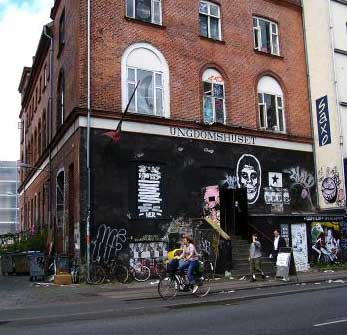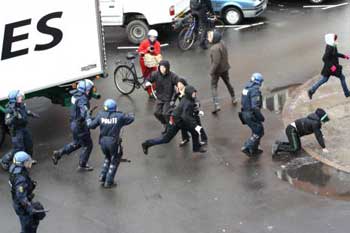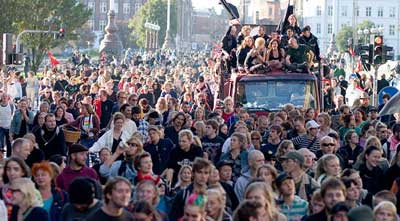In the morning hours of March 1, the police in Copenhagen finally raided the “Youth House”, a house that has been occupied for years by a movement of rebellious youth. Thousands of young people have come on to the streets to protest against this and violent clashes and riots have taken place in Copenhagen. It is necessary to understand what methods the movement must use in order to win.
This article first appeared in Socialistisk Standpunkt (www.marxist.dk), the Danish Marxist journal, on January 22. It is therefore written before the latest developments in the case, but it explains the basic position Marxists should take towards this question.
 |
The Youth House at Nørrebro |
Over the last couple of months a debate has opened up in Copenhagen and all over Denmark about The Youth House, a building that has been occupied for many years by a rebellious youth movement in Nørrebro, a neighbourhood in Copenhagen. This media-attention has been further strengthened by the occupation of another house, Villa-villakula in Copenhagen and the eviction of the occupants by the police towards the end of January.
The Youth House - which by the way is a historic building where the congress of the Second International was held and where both Lenin and Rosa Luxemburg had been - is now threatened with eviction. Discussions have begun in the media about the question of private property and the responsibility of politicians to provide cultural and youth activities. Additionally it has opened up a discussion in the Danish left about which methods and which strategy should be used in order to change society.
Bourgeois policies are responsible
First and foremost it is necessary to understand the origins of this conflict. In many bourgeois papers one can read comments and columns, which for no reason place all of the blame on the youth, portray them as violent criminals and thus try to free the politicians both in Copenhagen and nationally from any responsibility.
The problem is that this conflict around The Youth House has its origins in the frustration of big sectors of the youth with the present policy that is being carried out in Denmark. While Anders Fogh (the Danish prime minister) applauds Bush's war in Iraq, the welfare state, schools and hospitals are being destroyed. In terms of the labour market and conditions of work, many young people must work under the worst conditions, in many cases without contract, the right to sick leave, etc.
At the same time, there are no proper social and cultural opportunities for young people in local municipalities. In most places, youngsters must go to bars, cafés and dance clubs with extremely high prices, thus benefiting the private owners of the nightlife industry. The policy being carried out is in other words a bourgeois class policy that benefits the capitalists in that sector. The struggle to defend The Youth House and to get more youth houses must therefore be seen in this context. It is an attempt on the part of many young people to challenge this bourgeois policy and find some kind of alternative that makes room for socially and culturally oriented youth houses.
The polemic over Jagtvej 69 (The Youth House)
It is in this light that we must approach the polemic over the building at Jagtvej 69, which has been known as The Youth House since 1982, with music concerts, a popular kitchen, cultural activities, etc. From the beginning the municipal council of Copenhagen promised that the young people could use the building as a youth house. However, they changed their minds in 2000, when the house was sold to a small Christian sect, Faderhuset. Since then Faderhuset has insisted that they own the building and that they want the young occupiers out.
The bourgeois politicians, especially in Venstre (the government party), both in the municipal council of Copenhagen and in the government, have attacked the young people in the house ferociously and prevented any kind of resolution, such as the finding of another useable house. Ritt Bjerregård (the mayor of Copenhagen) has adopted a very vacillating attitude: on the one hand she has excused herself by bringing in the argument about the "right to private property"; on the other hand she has tried to reason and call for dialogue.
However, the fact is that the municipal council promised that the youth could use this house. This decision has since been reversed. The other excuses are very hollow. It is for example incredible that the politicians cannot find a youth house to the Copenhagen youth. Yet the government was very quick to construct a new Opera house for billions of kroner, and there is certainly no hesitation in making special laws every time A.P Møller (the biggest capitalist concern in Denmark) has new building projects. All this shows that the politicians carry out a clear policy - a class policy benefiting the capitalists.
The argument about the "sacred" right to private property is also false. Each time the state builds big projects for common society, for example new railroads, highways or bridges, the government can easily expropriate houses, plots, etc. surrounding the new construction. Compensation is normally given so that the owners can buy a similar building.
Why is this impossible with The Youth House in Copenhagen? A youth house after all, is something that benefits many young people in Copenhagen. Faderhuset is a small religious sect and they could be satisfied with any other building in Copenhagen. The only reason they are sticking so stubbornly to this house in particular is that they are getting media-coverage like never before.
Anarchist methods
Marxists are by no means neutral in this struggle. We think that the main responsibility for this conflict lies with the advocates of a bourgeois policy and with the capitalist system as a whole. We fight against the lies of the bourgeois and their malicious attack on The Youth House and every other cultural community of the youth and the people. We also think that the demand for more youth houses is an important demand that should be taken up as a significant part of the revolutionary struggle.
But at the same time we also think that many of the methods that some of the young autonomists have used in this struggle are wrong, and that their strategy is completely counter-productive to achieving their aims.
 |
Police repression against pro-Youth House protesters on March 1 |
Among many autonomist activists there is a an idea which says that the struggle for youth houses can be carried on as a struggle independent of wider political and trade-union struggles, that is to say, isolated from the class struggle. They see occupations of empty buildings as a means in itself. Of course the occupation of some houses can set more focus on the matter and get some media-coverage, but occupations in and of themselves solve nothing. They cannot win the struggle alone, cannot win if they are not part of a more fundamental battle to change society.
It is wrong to think that one can have a small sanctuary where there can be a "sample" of socialism, isolated from the surrounding capitalist world, with its cynical amoral and ruthless strain for profits. The problem is that this is absolutely impossible. If you want to hide yourself in your own little world, away from politics, you can try to close all windows, put a giant locker on the door and hide under the bed. But one day politics will come and knock on your door - and if you don't open, it will smash open the front door!
This is precisely what has happened with The Youth House, Christiania and every other attempt to create such sanctuaries. When you live in a capitalist society, you will inevitably be submitted to its mechanisms with its exploitation and oppression, whether you like it or not. And the moral and cultural norms that are dominant in society will always affect those who live in it.
All experience shows that it is impossible to make a small "commune" free from capitalism. If the struggle is not carried out as a general fight against capitalism and for the seizure of power nationally and internationally, all projects of that kind are doomed in advance.
At the same time we believe that the concrete tactics employed by some autonomist activists are absolutely counterproductive. For example, on December 16, a demonstration was converted into violence with individual fighting with the police and the smashing of shops along the avenue. There is no doubt that the police carry their part of the responsibility for these acts of violence and that the repression of the demonstration was brutal. But the autonomists played directly into the provocations of the police. These incidents seriously damaged the cause of The Youth House in the eyes of many ordinary people and gave free ammunition to the bourgeois politicians to step up their vicious attacks. Much of the sympathy that The Youth House had won amongst wider layers of the Copenhagen population, for example with important peaceful demonstrations of 4,000 and 5,000 just weeks before, were shattered with these outbursts of individual fighting and violence.
How the struggle can be won
 |
Big demonstration in defence of The Youth House - summer 2006 |
The only way to win this struggle is to turn it into a part of the class struggle. This is a class question and cannot be separated from the class struggle and from those methods and organizations that the working class has used traditionally. Each and every attempt to reduce the struggle to isolated occupations of houses or to street fighting with the police will fail miserably.
What is necessary is to take the demand for more youth houses up in the three workers' parties, in the Social Democratic Party, in the Socialist Peoples' Party, in the Unity-list and also throughout the whole of the trade-union movement, the student and apprentice movements, the renters movement, the organizations of unemployed, etc. These organizations have the necessary strength and mass following to make a wide-reaching campaign in defence of youth rights, including the right to youth houses.
If such a campaign were started, with the calling of big protest demonstrations against the policy of the government, the bourgeois politicians would find themselves seriously threatened. At the same time it would lower Anders Foghs credibility in the Danish population.
In this way it is not only possible to win the struggle for youth houses - which would be an important reform and a victory for the movement - but also to take a big step forward in the struggle against Fogh and his right-wing government and in the struggle to overthrow the capitalist system in Denmark and internationally.
